When deciding between hair‑loss and prostate‑enlargement drugs, Dutasteride ( Dutasteride is a dual 5‑alpha‑reductase inhibitor used to treat benign prostatic hyperplasia (BPH) and androgen‑dependent hair loss ) often tops the list, but it isn’t the only option. This guide walks you through how Dutasteride works, what its biggest pros and cons are, and how it stacks up against the most common alternatives such as Finasteride, Minoxidil, and Saw Palmetto.
What Exactly Is Dutasteride?
Dutasteride blocks both type I and type II isoforms of the enzyme 5‑alpha‑reductase, which converts testosterone into the more potent dihydrotestosterone (DHT). Lower DHT levels shrink an enlarged prostate and slow the miniaturisation of scalp hair follicles. In the United States the drug is sold under the brand name Avodart, while in many other countries it appears as Neadut.
How Dutasteride Differs From Finasteride
Finasteride (brand Propecia for hair loss and Proscar for BPH) inhibits only the type II isoform. Because Dutasteride targets both isoforms, it reduces DHT by up to 90 % compared with 70 % for Finasteride. The result is a slightly stronger effect on both prostate volume and hair‑loss progression, but the broader blockade also raises the chance of side‑effects.
Key Benefits of Dutasteride
- Higher DHT suppression: Up to 90 % reduction improves outcomes for men with moderate‑to‑severe BPH.
- Proven to halt hair‑loss progression in clinical trials lasting 24 months.
- Once‑daily oral dosing simplifies adherence.
- May reduce the need for surgical intervention in BPH patients.
Potential Drawbacks and Safety Concerns
- Sexual side‑effects (decreased libido, erectile dysfunction) occur in 4‑7 % of users.
- Rare reports of breast tenderness or enlargement.
- Longer half‑life (≈5 weeks) means side‑effects linger after stopping.
- Not approved for use in women or children; teratogenic risk for pregnant partners.
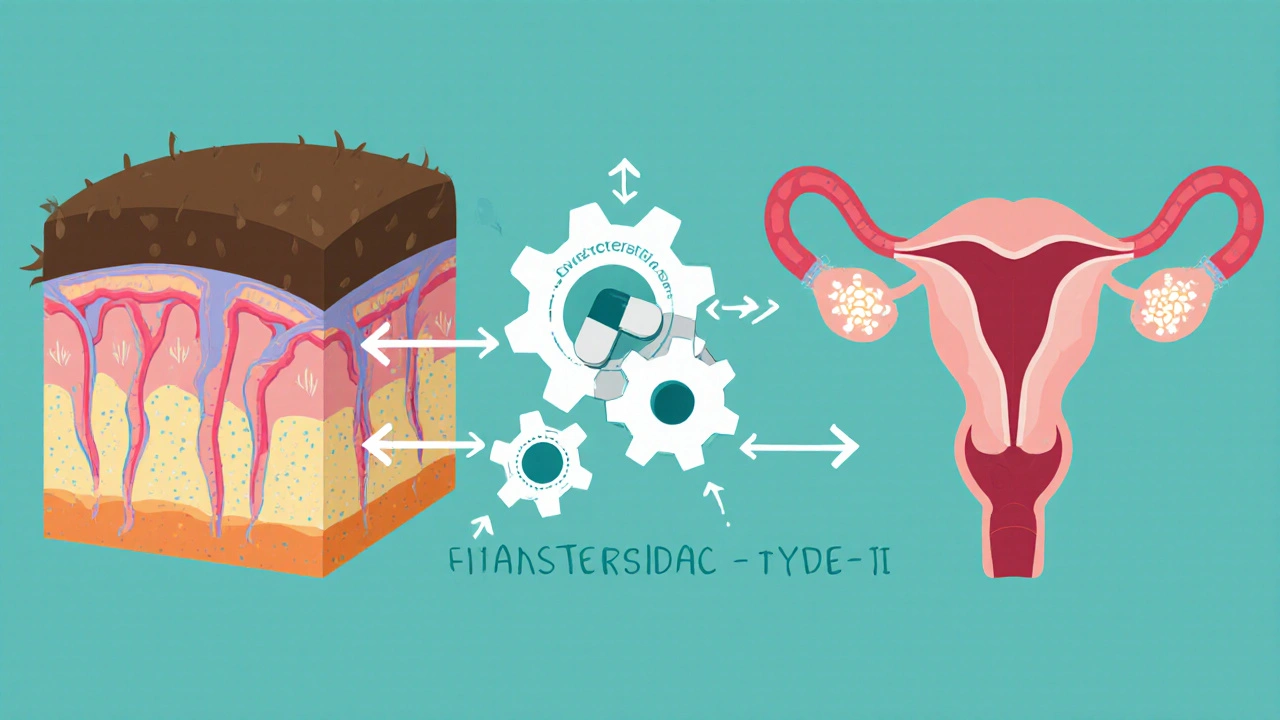
Common Alternatives - Quick Overview
Below is a snapshot of the most frequently cited alternatives and what they’re best at.
| Drug / Agent | Primary Indication | Mechanism | DHT Reduction | Typical Dose | Key Side‑effects |
|---|---|---|---|---|---|
| Dutasteride (Avodart) | BPH, androgenetic alopecia | Dual 5‑α‑reductase inhibitor (type I + II) | ≈90 % | 0.5 mg daily | Sexual dysfunction, breast tenderness |
| Finasteride (Proscar/Propecia) | BPH, androgenetic alopecia | Selective type II 5‑α‑reductase inhibitor | ≈70 % | 1 mg (alopecia) / 5 mg (BPH) daily | Sexual dysfunction, mood changes |
| Minoxidil (Rogaine) | Hair regrowth (topical) | Potassium channel opener, increases follicle blood flow | Not a DHT blocker | 2‑5 % solution or foam daily | Scalp irritation, unwanted facial hair |
| Saw Palmetto (extract) | Benign prostate symptoms, mild hair‑loss aid | Weak natural 5‑α‑reductase inhibition | ≈30‑40 % | 320 mg extract daily | Gastro‑intestinal upset, headache |
When Might You Choose an Alternative?
Understanding the trade‑offs helps you pick the right tool for your situation.
- Finasteride. Ideal if you prefer a medication with a shorter half‑life and a track record in both BPH and hair‑loss, especially when you’re sensitive to drug‑interaction risk.
- Minoxidil. The go‑to for people who want a topical solution, avoid systemic side‑effects, or combine it with an oral inhibitor for a two‑pronged attack.
- Saw Palmetto. Works best for men with mild BPH symptoms who want a “natural” option and are comfortable with modest DHT reduction.
- Combination therapy. Some dermatologists prescribe Dutasteride + Minoxidil to maximise hair‑loss control while keeping the daily pill dose low.
Decision Checklist - Is Dutasteride Right for You?
- Primary concern: Are you treating BPH, hair loss, or both? Dutasteride covers both; Finasteride leans more toward BPH or hair loss individually.
- Tolerance for side‑effects: If you’ve experienced sexual dysfunction on Finasteride, Dutasteride may increase that risk.
- Time to effect: Dutasteride often shows measurable prostate volume reduction within 3‑6 months; hair‑loss benefits can take 6‑12 months.
- Pregnancy considerations: Women who are pregnant or may become pregnant must avoid handling broken tablets - a caution less emphasized with topical Minoxidil.
- Cost & insurance: Generic Dutasteride is usually cheaper than brand‑name equivalents, but insurance formularies vary by country.
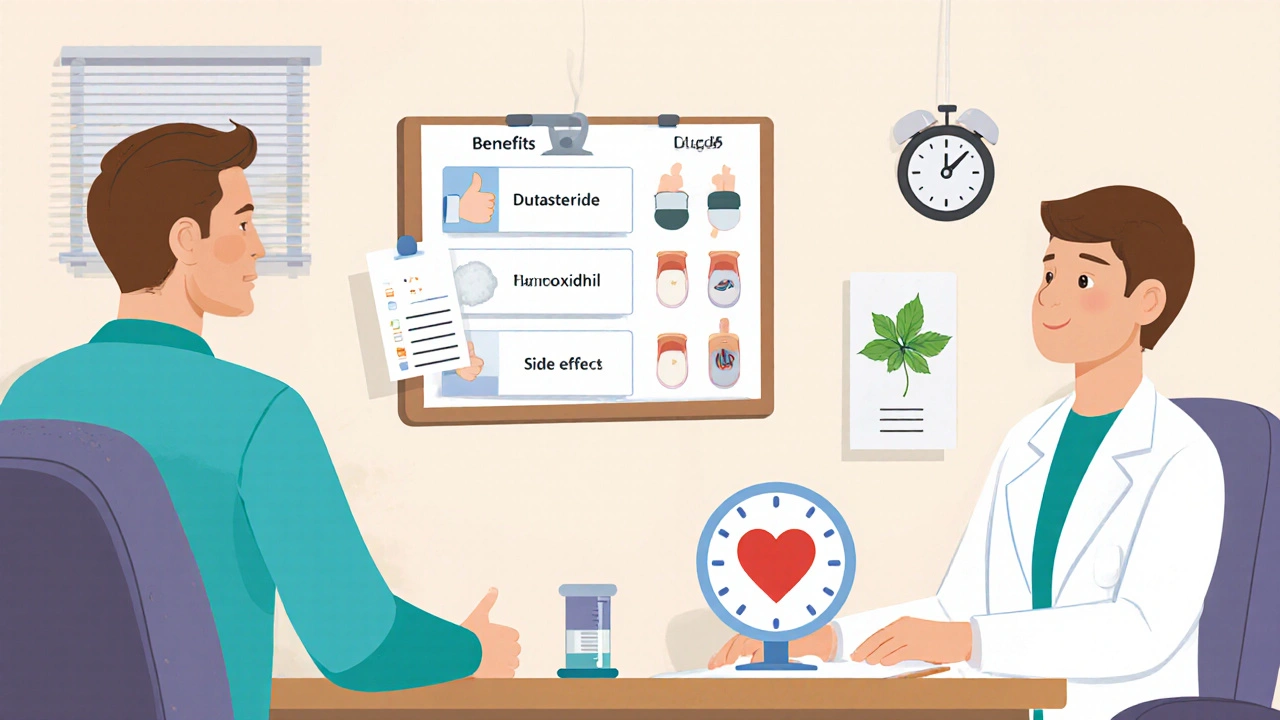
Practical Tips for Starting Dutasteride
- Take the tablet with food to minimise stomach upset.
- Schedule a baseline PSA (prostate‑specific antigen) test before beginning; repeat every 6‑12 months as advised.
- Monitor blood pressure; although rare, Dutasteride can affect fluid balance.
- Report any persistent sexual side‑effects to your physician; dose adjustment or switch may be needed.
Frequently Asked Questions
Frequently Asked Questions
Can I use Dutasteride for hair loss if I don’t have BPH?
Yes. Many men prescribe Dutasteride off‑label for androgenetic alopecia. The higher DHT suppression can slow thinning more effectively than Finasteride, but you should discuss off‑label use with a doctor.
How long does it take to see results for BPH?
Most men notice symptom improvement within 3‑4 months, and a measurable reduction in prostate volume after 6‑12 months of consistent dosing.
Is it safe to combine Dutasteride with Minoxidil?
Combining the two is common practice and generally safe because they work via different mechanisms. Always let your dermatologist know you’re on Dutasteride.
What should I do if I experience persistent sexual side‑effects?
Speak with your prescriber. Options include lowering the dose, trying Finasteride instead, or switching to a non‑systemic treatment like Minoxidil.
Does Dutasteride affect PSA test results?
Yes. Dutasteride can lower PSA levels by about 50 %, so labs often apply a correction factor when interpreting results.
Choosing between Dutasteride and its alternatives isn’t a one‑size‑fits‑all decision. By weighing the depth of DHT suppression, side‑effect profile, cost, and how quickly you need relief, you can land on the option that fits your health goals the best.
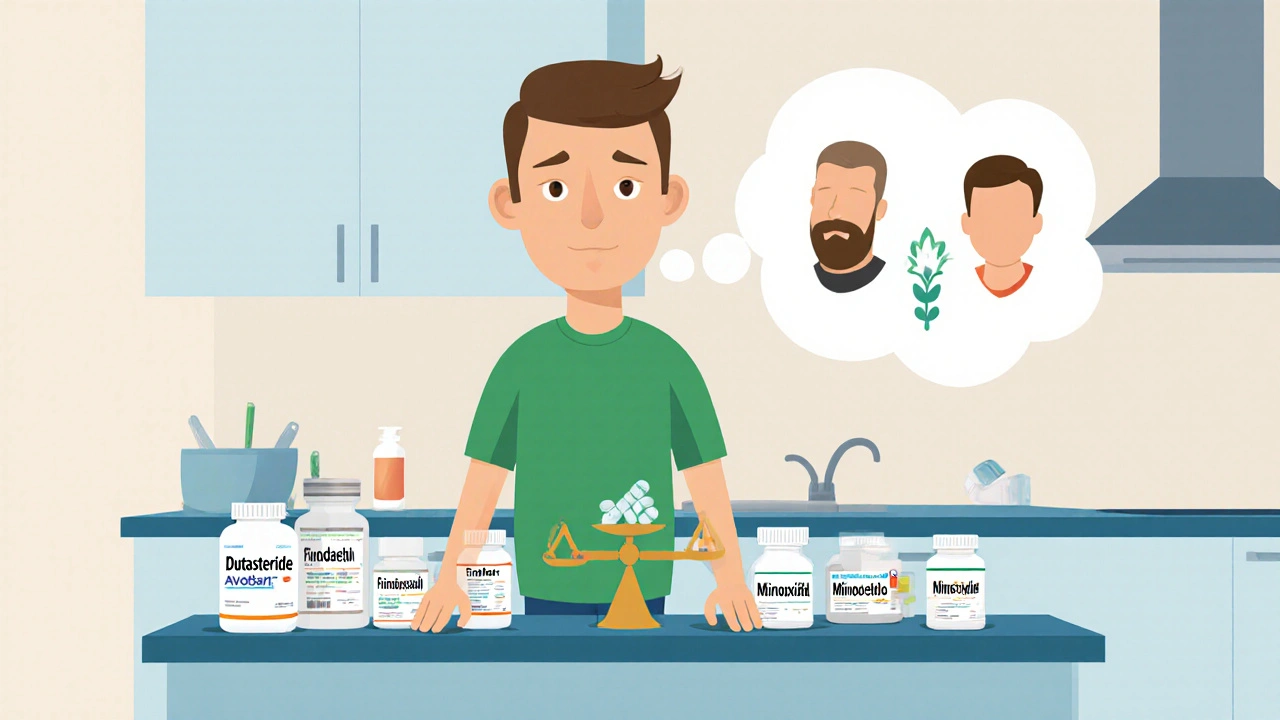
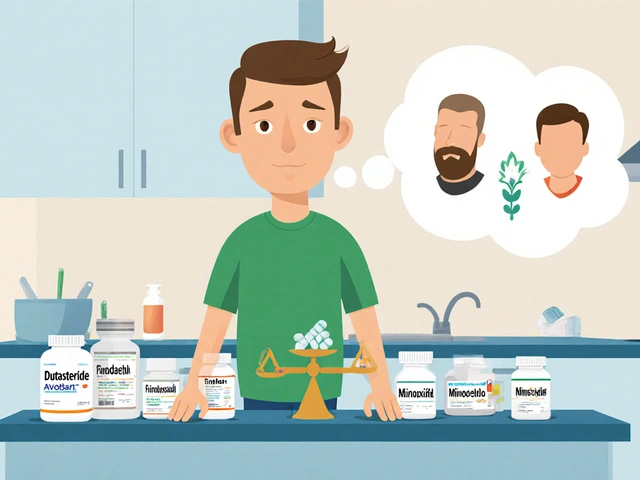


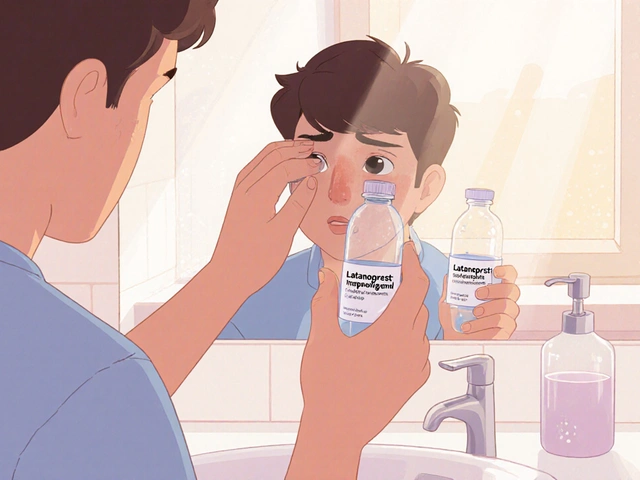

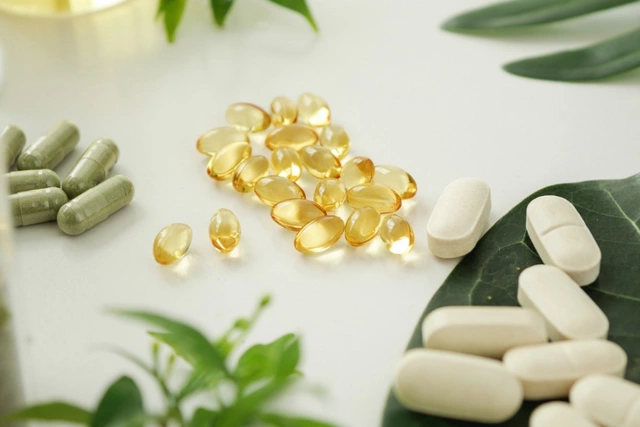

Poornima Ganesan October 18, 2025
Dutasteride's side‑effects are often downplayed in marketing.
Rajesh Singh October 23, 2025
It’s irresponsible to glorify a drug that can rob a man of his confidence; the sexual dysfunction reported in 4‑7 % of users is not a trivial footnote, it’s a life‑altering issue that many patients silently endure.
Albert Fernàndez Chacón October 27, 2025
Dutasteride’s dual inhibition of 5‑α‑reductase gives it a stronger DHT drop, which can translate to better prostate shrinkage and hair‑loss control, but the longer half‑life also means you’ll feel any adverse effects for weeks after stopping.
Drew Waggoner November 1, 2025
Reading the data feels like wading through a sea of hope and fear; the promise of 90 % DHT reduction sits next to the dread of lingering libido loss, and that tension can wear you down.
Liberty Moneybomb November 6, 2025
While the pharma giants shout about “efficacy”, they conveniently hide the fact that long‑term suppression of DHT might interfere with hormone balance in ways they haven’t fully disclosed-maybe it’s not just a side‑effect, maybe it’s a subtle form of control.
Linda A November 10, 2025
One could argue that the pursuit of a fuller mane reflects a deeper societal obsession with youth, yet we must ask whether the trade‑off of altered endocrine function is philosophically justifiable.
Karla Johnson November 15, 2025
When evaluating Dutasteride versus its alternatives, the first point to acknowledge is the sheer magnitude of DHT suppression it achieves, which undeniably sets a high bar for efficacy.
However, that numerical advantage does not automatically translate into a superior clinical experience for every patient.
The pharmacokinetic profile, with a half‑life approaching five weeks, means that any adverse reactions linger long after the pill is missed, creating a lingering shadow over daily life.
In contrast, Finasteride’s shorter half‑life offers a quicker wash‑out period, granting physicians more flexibility in managing side‑effects.
Moreover, the psychological impact of persistent sexual dysfunction can erode self‑esteem, leading to secondary mood disturbances that are rarely captured in short‑term trials.
Patients who are already dealing with the stress of BPH or androgenic alopecia may find themselves caught in a feedback loop of anxiety and physiological change.
From a cost perspective, generic Dutasteride is often affordable, yet insurance coverage can vary dramatically across regions, sometimes making the drug financially prohibitive.
Alternatives like Minoxidil, while lacking systemic DHT suppression, avoid systemic side‑effects entirely and can be combined with oral agents for a synergistic approach.
Saw Palmetto, on the other hand, offers a modest DHT reduction and appeals to those seeking a ‘natural’ remedy, though the evidence base remains thin.
Clinicians must also consider the impact on prostate‑specific antigen (PSA) levels; Dutasteride can halve PSA values, necessitating adjusted interpretation when monitoring for prostate cancer.
The necessity of baseline PSA testing before initiation adds another layer of clinical responsibility that some practitioners may overlook.
Patient education, therefore, becomes a cornerstone of safe therapy, ensuring individuals understand both the benefits and the lingering risks.
When discussing treatment plans, shared decision‑making should incorporate the patient’s tolerance for potential side‑effects, lifestyle constraints, and personal health priorities.
The availability of combination therapy-such as Dutasteride paired with topical Minoxidil-provides a compelling option for those desiring maximal hair‑loss control while attempting to mitigate systemic exposure.
Nevertheless, it remains essential to monitor for any new symptoms, even those that appear months after starting treatment, due to the drug’s prolonged presence in the body.
In summary, while Dutasteride’s potency is impressive, the holistic picture demands a nuanced appraisal that balances efficacy, safety, cost, and patient values.
Mike Hamilton November 19, 2025
Dutasterie is a strong med but you should check ur doc before startin it.
Matthew Miller November 24, 2025
Give it a go and you might see that stubborn hair finally give up its hiding game!
Alex Lineses November 29, 2025
Combining the oral inhibitor with a topical minoxidil regimen can synergistically target follicular miniaturization while minimizing systemic exposure, so consider an integrated protocol under dermatologist guidance.
Margaret pope December 3, 2025
it works but watch the side effects
Emma Williams December 8, 2025
Dutasteride offers a potent DHT cut but talk to a doctor first
Stephanie Zaragoza December 13, 2025
Indeed, while the drug delivers approximately a ninety‑percent reduction in dihydrotestosterone-a figure that sounds impressive on paper-the clinician must also weigh the statistically significant increase in sexual dysfunction, the documented cases of mastalgia, and the necessity for regular PSA monitoring, all of which demand a comprehensive risk–benefit analysis before prescribing.
Tracy O'Keeffe December 17, 2025
One must not simply vomit the term “alternative” without interrogating the epistemic scaffolding that undergirds our pharmaco‑cultural mythos; the very notion that a synthetic inhibitor can outclass the humble Serenoa repens is a narrative steeped in commercial bias, not in unbiased teratological truth.